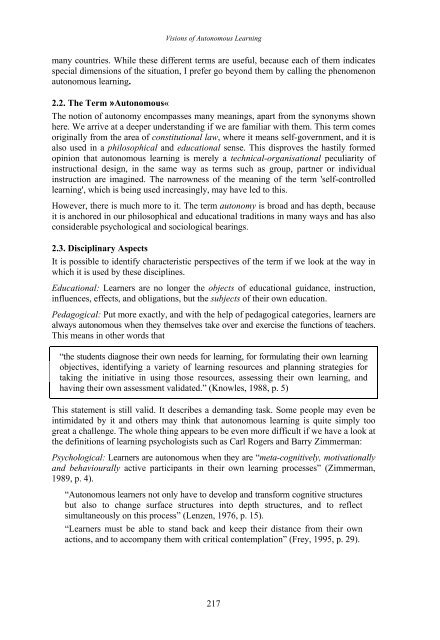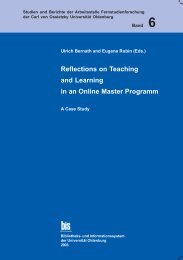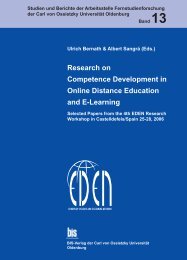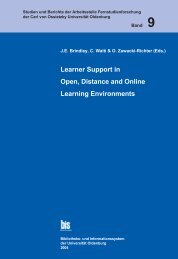Distance Education in Transition - Master of Distance Education ...
Distance Education in Transition - Master of Distance Education ...
Distance Education in Transition - Master of Distance Education ...
Create successful ePaper yourself
Turn your PDF publications into a flip-book with our unique Google optimized e-Paper software.
Visions <strong>of</strong> Autonomous Learn<strong>in</strong>g<br />
many countries. While these different terms are useful, because each <strong>of</strong> them <strong>in</strong>dicates<br />
special dimensions <strong>of</strong> the situation, I prefer go beyond them by call<strong>in</strong>g the phenomenon<br />
autonomous learn<strong>in</strong>g.<br />
2.2. The Term »Autonomous«<br />
The notion <strong>of</strong> autonomy encompasses many mean<strong>in</strong>gs, apart from the synonyms shown<br />
here. We arrive at a deeper understand<strong>in</strong>g if we are familiar with them. This term comes<br />
orig<strong>in</strong>ally from the area <strong>of</strong> constitutional law, where it means self-government, and it is<br />
also used <strong>in</strong> a philosophical and educational sense. This disproves the hastily formed<br />
op<strong>in</strong>ion that autonomous learn<strong>in</strong>g is merely a technical-organisational peculiarity <strong>of</strong><br />
<strong>in</strong>structional design, <strong>in</strong> the same way as terms such as group, partner or <strong>in</strong>dividual<br />
<strong>in</strong>struction are imag<strong>in</strong>ed. The narrowness <strong>of</strong> the mean<strong>in</strong>g <strong>of</strong> the term 'self-controlled<br />
learn<strong>in</strong>g', which is be<strong>in</strong>g used <strong>in</strong>creas<strong>in</strong>gly, may have led to this.<br />
However, there is much more to it. The term autonomy is broad and has depth, because<br />
it is anchored <strong>in</strong> our philosophical and educational traditions <strong>in</strong> many ways and has also<br />
considerable psychological and sociological bear<strong>in</strong>gs.<br />
2.3. Discipl<strong>in</strong>ary Aspects<br />
It is possible to identify characteristic perspectives <strong>of</strong> the term if we look at the way <strong>in</strong><br />
which it is used by these discipl<strong>in</strong>es.<br />
<strong>Education</strong>al: Learners are no longer the objects <strong>of</strong> educational guidance, <strong>in</strong>struction,<br />
<strong>in</strong>fluences, effects, and obligations, but the subjects <strong>of</strong> their own education.<br />
Pedagogical: Put more exactly, and with the help <strong>of</strong> pedagogical categories, learners are<br />
always autonomous when they themselves take over and exercise the functions <strong>of</strong> teachers.<br />
This means <strong>in</strong> other words that<br />
“the students diagnose their own needs for learn<strong>in</strong>g, for formulat<strong>in</strong>g their own learn<strong>in</strong>g<br />
objectives, identify<strong>in</strong>g a variety <strong>of</strong> learn<strong>in</strong>g resources and plann<strong>in</strong>g strategies for<br />
tak<strong>in</strong>g the <strong>in</strong>itiative <strong>in</strong> us<strong>in</strong>g those resources, assess<strong>in</strong>g their own learn<strong>in</strong>g, and<br />
hav<strong>in</strong>g their own assessment validated.” (Knowles, 1988, p. 5)<br />
This statement is still valid. It describes a demand<strong>in</strong>g task. Some people may even be<br />
<strong>in</strong>timidated by it and others may th<strong>in</strong>k that autonomous learn<strong>in</strong>g is quite simply too<br />
great a challenge. The whole th<strong>in</strong>g appears to be even more difficult if we have a look at<br />
the def<strong>in</strong>itions <strong>of</strong> learn<strong>in</strong>g psychologists such as Carl Rogers and Barry Zimmerman:<br />
Psychological: Learners are autonomous when they are “meta-cognitively, motivationally<br />
and behaviourally active participants <strong>in</strong> their own learn<strong>in</strong>g processes” (Zimmerman,<br />
1989, p. 4).<br />
“Autonomous learners not only have to develop and transform cognitive structures<br />
but also to change surface structures <strong>in</strong>to depth structures, and to reflect<br />
simultaneously on this process” (Lenzen, 1976, p. 15).<br />
“Learners must be able to stand back and keep their distance from their own<br />
actions, and to accompany them with critical contemplation” (Frey, 1995, p. 29).<br />
217





